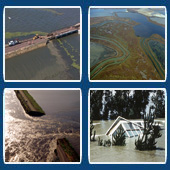


Levee System Integrity Program
CALFED’s Levee System Integrity Program provides long-term protection for vast resources in the Delta by maintaining and improving the integrity of the estuary’s extensive levee system. These resources include not only the quality of the Delta’s water and the health of its ecosystem, but the 500,000 people who call the Delta home, the many towns and villages in the Delta, infrastructure such as utilities and transportation corridors, and economic assets of thriving agriculture and recreational industries.
- What are the goals of the Levee System Integrity Program?
- History of the Levee System Integrity Program.
- How does the Levee System Integrity Program effect residents, industry and the environment?
- What progress has been made in meeting Levee System Integrity Program objectives?
- What benefits have been achieved for the CALFED Levee System Integrity Program?
- What has been spent to date on the Levee System Integrity Program and how has this been funded?
- What state and federal agencies are responsible for the Levee System Integrity Program?
- What are the most notable success stories of the Levee System Integrity Program since its inception?
- Who is the contact person for this program objective?
What are the goals of the Levee System Integrity Program?
The goal of the Levee System Integrity Program is to reduce risk to land use and associated economic activities, water supply, agriculture and residential use, infrastructure and the ecosystem from the effects of catastrophic breaching of Delta levees.
History of the Levee System Integrity Program.
Levees in the Delta date back to the mid-1850s, when Congress authorized reclamation in the previously-marshy Delta. The pre-existing natural low embankments carved over years of natural flow were built up and enlarged, thus creating the basis for the Delta’s maze of channels and sloughs of today. As the levees aged and were further altered by man, supporting structures such as roads, bridges, homes, and the islands they created, concern grew over their strength and integrity as those islands subsided lower than the water in the surrounding leveed channels. As an integral part of the state’s water system, the integrity of the Delta’s levee system became a major objective in the CALFED Program. Funding and focus on Delta levees heightened considerably after levee breaks and flooding in the wake of Hurricane Katrina devastated the city of New Orleans.
How does the Levee System Integrity Program affect residents, industry and the environment?
Through its maintenance and improvement work, the Levee System Integrity Program provides long-term protection from levee system failure that could have a catastrophic effect on human life and the state’s economy. The Delta has been characterized as the next New Orleans waiting to happen. While California does not experience hurricanes, earthquakes are a reality that could create similar devastation. Unlike New Orleans’ levees, which serve to keep water out of low-lying neighborhoods of the city, Delta levees also serve as channels for the majority of the state’s fresh water supply and maintain its separation from the intrusion of salt water onto valuable assets and services. A disruption of this system would cripple California’s ability to provide an adequate water supply to its population, including industry sectors that rely on a fresh water supply, and would thrust Delta species into a dramatically altered environment that could threaten their survival.
What progress has been made in meeting Levee System Integrity Program objectives?
The CALFED Record of Decision requires that the Levee System Integrity Program be managed to provide for long-term protection for Delta resources through maintenance and improvement of the Delta levee system. Details of the Levee System Integrity Program performance are available in the Program Performance section of this website.
What benefits have been achieved for the CALFED Levee System Integrity Program?
Since 2000, protection for and maintenance of nearly 700 miles of Delta levees has been increased, with ongoing maintenance of more than 600 miles of eligible project and non-project levees undertaken. Further, stability was improved for more than 45 additional miles of levees. Significant levee rehabilitation projects have been undertaken on numerous islands, along with native vegetation growth projects and restoration, reuse of more than 2 million cubic yards of dredge material for levee stability and habitat development, and development of approximately 50 acres of riparian and wetland habitat and 3,000 linear feet of shaded riverine aquatic habitat.
What has been spent to date on the Levee System Integrity Program and how has this been funded?
By the end of Stage 1, program expenditures were expected to reach $444 million. Details of Levee System Integrity Program expenditures are available in the Program Performance Projects by Objective section of this website.
What state and federal agencies are responsible for the Levee System Integrity Program?
Implementing agencies for the Levee System Integrity Program are the California Department of Water Resources, the California Department of Fish and Game and the U.S. Army Corps of Engineers.
What are the most notable success stories of the Levee System Integrity Program since its inception?
Protection and maintenance of a total of 1,300 miles of project and non-project levees has taken place since the inception of the CALFED Program in 2000. Other major undertakings include restoration of native vegetation and reuse of dredge material to bolster levee stability. Perhaps the most notable success of the program has been the heightened knowledge and concern for Delta levees that has been placed upon them by state and federal government officials in the wake of Hurricane Katrina.
Who is the contact person for this program objective?
Avery Estrada, Engineer
Department of Water Resources
Bay-Delta Levee Special Projects
1416 9th Street, Room 1641
Sacramento, CA 95814
(916) 651-0865
aestrada@water.ca.gov
Russ Rote, P.E., CFM
Delta Program Manager
Sacramento District
U.S. Army Corps of Engineers
1325 J Street, Room 902
Sacramento, CA 95814-2922
(916) 557-6672
russ.l.rote2@usace.army.mil





